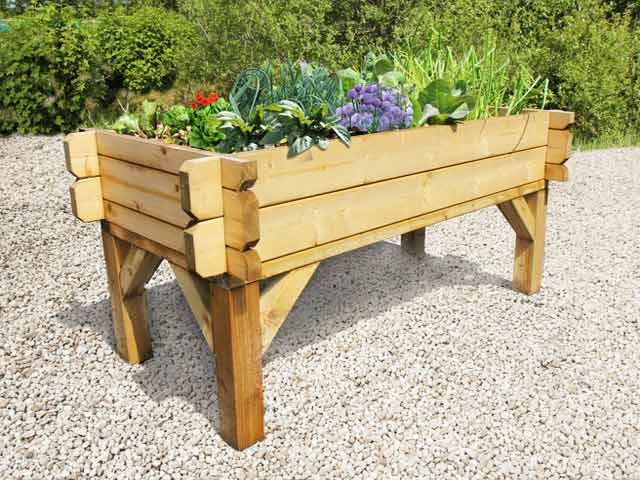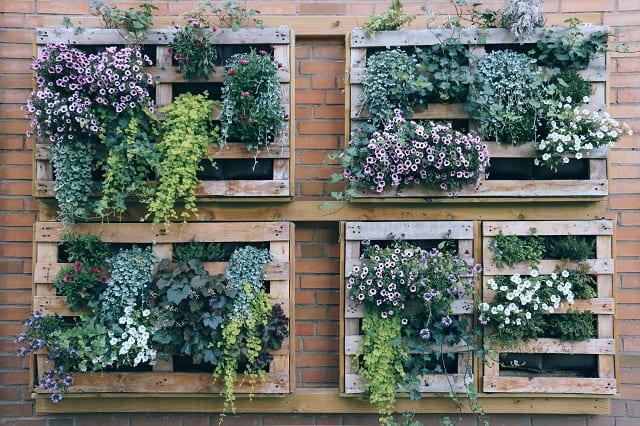
Create the green space of your dreams, whatever your physical ability
With gardening season just around the corner, we are excited to introduce BBC Gardener’s World and BBC Morning Live presenter Mark Lane as Stannah’s Gardening Expert.
In his first blog, Mark shares his advice and tips on designing a garden for anyone, of any ability, to use.
As a garden designer I love the process of pulling together ideas, drawing up concepts, creating planting plans and selecting materials to use. I trained to become a garden / landscape designer; but I completely understand that faced with a blank canvas, an overgrown garden or downsizing to a patio, terrace or balcony can feel daunting.
If you love gardening but your body is starting to ache in areas that never ached before, you find yourself needing to use a walking frame, stick or wheelchair, or are keen to future-proof your home and garden, then what should be a wonderful creative past-time can turn into a nightmare of a project.
I’m here to tell you, however, that with some planning and taking your time you can create the outdoor space of your dreams. Remember: every garden reflects the owners’ or gardeners’ personality and this is why I love visiting gardens. Even if a garden style such as a cottage garden has been followed by three or even a hundred people, each one will be completely different. And that is why gardening and gardens are so magical.
Get to know your body, abilities and possible limitations
First, think about your own body. How far can you reach? Can you kneel or will you need, or prefer, to garden from a seated position? Can you twist your upper torso? Do you still have good dexterity in your hands? Can you manage steps or is a ramp a better option? Can you twist your wrists? Understanding your own body is key to making a garden work for you. For example; if you cannot twist your body and need, or would prefer, to sit down when gardening then a raised bed with flat sides isn’t advisable. Instead, go for a raised table or manger so that you can get your knees underneath and work at a comfortable height without having to twist or turn.

Finding your perfect garden style
Do you like a particular style of gardening, such as cottage, prairie, sensory, seaside, tropical or modern? Understanding the look and feel of each is paramount for getting it right. There are thousands of images online showing different garden styles. Start collecting them and produce a mood board. Sometimes it might be the smallest detail of a handcrafted door handle that you like — the shape, the craftsmanship and / or the material might appeal. This, in turn, could steer you towards an ‘arts and crafts’ style garden, for example.

An example of a ‘cottage garden’, characterised by an informal mix of bulbs, herbaceous perennials, annuals and vegetables closely planted and jostling together in gay abandon. Colours sweep in and out from cool shades to rich shades depending on the season.
Next, consider the materials that you want to use. Natural materials — such as stone, gravel and wood — lend themselves to traditional styles. On the other hand, clean-cut, porcelain tiles, a monochrome palette or strong architectural features and modern sculpture are better for modern or contemporary gardens. Remember, there are no rules other than your own. You may even like to mix up materials and aim for an eclectic look.
January, February and even March are the perfect times to sit down with a cuppa, a blank piece of paper or your laptop and get your thinking cap on. Sometimes, paper cut outs in different shapes, representing a table and chairs or a shed, can be moved around until you find the right balance. You could treat this as a retirement pursuit with your partner or ask little ones for their help in designing a dream garden.

Design tricks and tips
Here are my recommendations to help you create the perfect garden:
- Take measurements of the garden, patio or balcony — especially the width and length. If the garden leads off the back or front of the house, sit back with a coffee and biscuit (or two). Then, watch where the sun comes up and where shadows fall in the garden; will the area close to the backdoor be in full sun all day, or be in partial shade? Draw lines leading off from windows and doors, as these will become sight lines.
- Be inspired by the bricks or stone on your property: Look at your home, and even neighbouring properties or houses in the area, then tie in their colour with the materials that you want to use. Be a little nosey and see what is growing in neighbours’ gardens; taking note of plants in the larger environment will help when it comes to selecting your own greenery, which in turn will help wildlife.
- Think about the size of your patio or paved area — especially if you have down-sized. Entertaining may be off the cards for now but, in preparation for reuniting with family and friends, ensure this area is big enough for a table and chairs (even with the chairs pushed outwards).
- Consider a folding table and chairs. This will mean you can still hold a cocktail party or a book club outdoors when the time is right, without losing precious space. Light-weight furniture is advisable if you struggle a little with mobility or strength
A pathway fit for purpose
If you need to get from the back or front door to a gate, a shed or garage then consider a pathway. Ideally aim for a path c.1.2-1.5m wide, which is wide enough for two people to walk side-by-side, in a wheelchair or using a frame or stick. To stop wheels — and feet for that matter — ending up in a flowerbed, install a raised edge, either using a wooden gravel board (the board found at the bottom of a fence) or a concrete edger that stands proud c. 10cm above ground level.
For the pathway, consider paving slabs rather than gravel, as little stones are very difficult for wheelchair wheels to navigate. Paving should be pointed with a minimum gap of 10mm. You want a firm, stable, non-slip surface. In some instances, anti-glare paving slabs are a good idea — especially for partially sighted or blind people.
If you need to hold onto something when walking about the garden, then consider hanging a rope through hoops or install a support rail. Think about the material you want to use. Metal can be cold to the touch, especially in winter, whereas rope and wood feel warmer. Metal can be smoother, whereas wood and rope might need protecting and repairing.
Raised beds and elevated gardening
Lifting the garden up to a manageable height is really key to a workable garden. As mentioned earlier, this can be a raised bed if you can twist your body, or simply taller containers. If you put lockable wheels on to the bottom of the containers, then you can move them around your outdoor space with ease.
If you are planning a permanent raised bed then do not make it any wider than 1.2m, especially if you can only access it from one side. If you use treated softwood sleepers laid on their longer flat edge you can create a perching spot all the way around the soil area, enabling you to garden sitting down.
If you’re using brick or blockwork, try and aim for a frame c. 20-30cm wide, which is just big enough to perch on. Soil in raised beds will eventually drop, so liners are a good investment. They keep the soil within the raised bed, but they too will not stop soil from settling. The great thing though, is that it is easier to top up with compost or topsoil.

Tight on space? Why not consider a vertical garden?
If you want to grow delicious veggies or fruit but are limited on space, then consider a vertical garden. This trendy technique involves growing plants on a vertically suspended panel, that’s either freestanding or attached to a wall. There are several vertical gardens on the market now; some even come with individual pots for plants so you can swap and change them around to get maximum sunlight. They can be made up of either ornamental or edible plants, and even wildflowers. Starter kits are also available from retailers like Waitrose.
If you love the idea of gardening, but don’t have the luxury of time to maintain it or would like to save water, then a self-watering system may be for you. Here’s where it gets a little technical. You need an irrigation system (for example, a leaky hose or small irrigation pipes and nozzles that drip-feed and nourish your plants) plus a water collecting reservoir at the bottom.
A solar-powered pump allows you to set a timer for when your plants get watered during the day —you can even add liquid feed! As the pump starts to work, just the right amount of water and feed will be forced through the pipes and onto the soil or coir. But rest assured, a good old-fashioned long-spout watering can or a hose with an attachment on the end can work just as well.

Hanging baskets are also a wonderful way of adding colour, texture and scent to a small space. Read my 10 steps and top tips to creating bountiful hanging baskets — from positioning to the perfect plants, regardless of your physical ability.
Hopefully, I have spurred you into action to design and create a garden that anyone can enjoy, no matter your level of ability. Ultimately, gardening is great for your mental and physical health. There’s no better feeling that venturing out into the fresh air to cultivate — and later admire — a stunning, scented sanctuary. The whole gardening process, from initial doodles to nurturing plants and produce within it, is such a fulfilling, fun hobby.
Set your garden goal and with creativity, dedication and patience you’ll soon reap what you sow!
Stay up to date
Latest Blogs

Whole Home Comfort with Stannah and HSL

Dame Zandra Rhodes x Stannah: When accessibility meets style
Could more people benefit from home adaptation support for hidden disabilities?
50 years of Stannah Stairlifts – A milestone grounded in purpose

BBC’s Dr Punam Krishan reveals a little-known Parkinson’s symptom to watch for...

Are you at risk of falling? Dr. Punam Krishan’s simple 12-second test could tell you...

Snore Wars: Could sleeping separately be the secret to a better night’s rest?

Proud to carry the Made in Britain mark!
Stairlifts made for you
All our stairlifts whether straight or curved are customised to suit you and your home so call now to arrange a visit to get your FREE personalised quote!